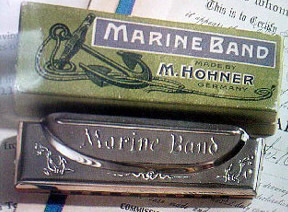The Sailor’s Hornpipe [..with tab]
 All the nice girls love a sailor
All the nice girls love a sailor
As an island nation, a good deal of Britain’s military, economic and cultural tradition is drawn from its seafaring experience. So what better way to mark the romance of our heritage than a good old sea shanty?
A few years ago the Doc was chaperoning the West Sussex Youth Orchestra on their tour of Germany and Austria. As a finale to each concert, the orchestra chose to perform Sir Henry Wood’s wonderful Fantasia Of British Sea Songs, a fulcrum of the annual last night of the Proms. The prize number from the fantasia is the Sailor’s Hornpipe. ‘Tis music to stir the heart of any a true Brit; and as the revellers display the glorious eccentricities of their patriotic pride, you just can’t wait for that Mr.Toad car horn and a frenzied climax which, with every tin of spinach on the planet, even Popeye could not sustain.
All the nice girls love a tar
And just before we launch into our own rendition, let’s pay credit to the real inspiration for this piece when played on the harmonica. As a schoolboy, the young Doc was spellbound one Saturday morning when he tuned in his telly and saw Huey Lewis wandering the Kids’ TV studio, armed with a blues harp and nonchalantly playing the Sailor’s Hornpipe. How on earth did he do that? The answer, as always, is with practice.
Bright and breezy, free and easy
So, to launch you on your voyage of discovery, here are two ways to tackle this tricky tune. The first version is ‘by the book’ (although you can take a leaf from Charlie McCoy’s manual and use two major diatonic harps tuned a tone apart – as indicated in blue). The second version is the Good Doctor’s own arrangement for beginners – not entirely faithful to the original, but easier to master as it avoids any bends.
A major (and B major) diatonic harp(s) in 1st position…but you can use any two harps tuned a tone apart
7B..7D..7B 4B 4B
6B..5D 5B..6B 7B..7D 7B..8B
8D..7B..8D 4D 4D
4D..4B 3D..4D 6B..6B
6D..7D 7B..7D..6D..6B
6D..6B..5D..5B
5D..5B..4D..4B
4B..3D..3D”..2D
3D”..4B 3D..4D 4B..5D
5B..4D..5B 4B 4B
6B.. 5D..
5B..6B..7B..6B
5B..6B..7B..6B
6D 5D 5D
3D”..2D 6B.. 5D..
2D’..3D”..4D..3D” 5B..6B..7B..6B
2D’..3D”..4D..3D” 5B..6B..7B..6B
3D 2D..2D 6D 5D 5D
5B
5D..5B..5D..6B
6D..6B..5D..5B
5D..5B..4D..4B
4B..3D..3D”..2D
3D”..4B 3D..4D
4B..5D..5B..4D
5B 4B 4B
The Good Doctor’s arrangement (also on an A major diatonic)
7B..7D..7B 4B 4B
6B..5D 5B..6B 7B 7B..
7D..7B..8D 4D 4D
4D..4B 3D..4D 6B..6B..
6D..7D 7B..7D..6D..6B
6D..6B..5D..5B
5D..5B..4D..4B..3D
..2D
3D..4D 4B..5B 4D..4D
5B..4D..5B 4B 4B
6B.. 5D..
5B..6B..7B..6B
5B..6B..7B..6B
6D 5D 5D
5D…
2D..3D..4D..3D
2D..3D..4D..5D
5B 4B..4B
5B
5D..5B..5D..6B
6D..6B..5D..5B
5D..5B..4D..4B
3D..
..2D
3D..4D 4B..5B 4D..4D
5B..4D..5B 4B 4B
It should sound something like this:

Thanks for tab will put it to good use for my single row button accordion as like playing early aussie folk on it as well as Irish/English and fiddle tunes.Your tab for Walter Horton Boogie was great. We cant always be great at blues so bit of traditional music helps keep the interest and often like useing lower register and bending notes for the scale as is good practice but cannot do that on the button accordion however it does have 2 octaves on key board and 3 octaves to choose as well as tremol0.
So many people associate harmonica with blues but lovely to hear traditional stuff played on them.
The National library here in Oz has a cd called the Meredith collection where a lot of old timers were recorded in the 60,s on reel to reel tape with harmonicas,accordions etc as they were easy to carry about and local bush band has transcribed to music as a lot of tunes were passed on .I am told a similar thing was done over in the states .Thanks for a useful site Ian
G’day Possums! I love the tradtional folk stuff on harmonica too. Some of the tremelo players can sound just like a squeeze box. We have a national treasure here in Sussex I hope to bring to the Harp Surgery before too long.